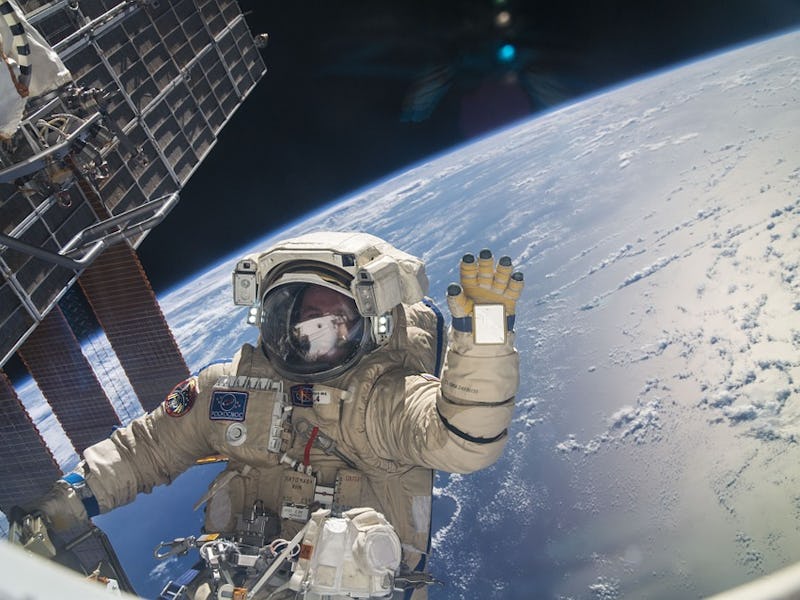"Muscle Injections" Could Be a Game-Changer for Astronauts and People in Casts
A new trial addresses a pressing issue in space exploration.

When NASA astronaut Andrew Feustel returned to earth after 197 days in space, he was in remarkably good health. But as he took his first shaky steps back under the weight of Earth’s gravity, he faltered. Like so many before him, and the scores of future space colonists who will likely come after him, he struggled to overcome the ravages of microgravity on his muscles. Fortunately, research published Thursday in FASEB shows they could be treated with a well-placed injection.
"We’re thinking about the possibility of using these cells in the recovery process following exposure to the microgravity environment."
Weightlessness is definitely one of the cooler experiences of space travel, but it takes its toll. When astronauts spend extended time in space, the lack of gravity leads to losses in bone density and muscle mass. NASA has rehabilitation programs that help astronauts recover upon returning to Earth, but Marni Boppart, Ph.D., the new paper’s first author and an associate professor at the University of Illinois Beckman Institute, believes that she’s found a way to jumpstart that process: a quick injection of cells directly into the muscle.
In a mouse trial published Thursday in FASEB, she showed that these muscle injections, made from cells called pericytes, enhanced muscle regrowth in nice that experienced muscle loss very similar to that seen during spaceflight.
“During spaceflight we can contract our muscles, but there isn’t the mechanical stimulus that helps to maintain muscle mass,” Boppart tells Inverse. “We’re thinking about the possibility of using these cells in the recovery process following exposure to the microgravity environment.”
Pericytes are found around the blood vessels in the muscles of both humans and mice, and when muscles aren’t active, pericytes degrade and muscle mass declines. In her experiment, Boppart watched the muscle fibers and pericytes decline in tandem: Mice whose hind limbs were immobilized for 14 days lost these cells and muscle fibers at a rapid rate compared to mice that were allowed to wander freely. A similar phenomenon happens when our muscles atrophy when they’re not used. Just think about the muscle loss that happens while a limb is immobilized in a cast.
Recovering lost muscle takes time, energy, and the slow process of physical therapy. But Boppart’s strategy speeds things up considerably. When the team re-injected populations of pericytes back into mice starting their own muscle recovery process, they found that the injections made a huge difference. By the end of just two weeks, the mice who received injections had completely recovered, whereas control mice still had significantly reduced muscle mass.
“We decided based on that finding that we could potentially transplant these cells to replace the pericyte loss, and that would help with the recovery process,” says Boppart. “What we found was in fact that the perricyte injection was very beneficial in enhancing the recovery of muscle.”
Astronauts exercise aboard the ISS to mitigate muscle and bone loss, but they still have to go through rehabilitation once they return to earth.
Boppart thinks that pericytes do more than just replace lost muscle cells. She believes that they excrete extracellular vesicles — tiny packages that cells sometimes use to communicate — of therapeutic agents that stimulate the regrowth of muscle and, crucially, the regrowth of capillaries, the vessels that deliver oxygen-rich blood to muscles.
“We know that these cells are very beneficial,” she says. “But when we’re thinking about our future studies we’re hoping to actually extract the important regenerative materials from these cells. So what we’re hoping to do is to extract the extracellular vesicles secreted by the pericytes in the blood stream, and hopefully inject those derived from a person, back into that same individual.”
Going forward in human studies, her work will likely focus on mining the riches of and developing a personalized muscle-restoration injection that, in combination with exercise, will help restore muscle. Ideally, these injections should greatly reduce the time it takes human astronauts to reacclimatize to life on their home planet, and perhaps even help people who have spent months recuperating in casts or in hospital beds get back up to full speed.
Boppart will still have to test her process in humans, but her finding is coming at a particularly salient time. Right now, we’re pushing society further into space, but we’re still not sure space will leave them strong and healthy enough to come back home.
Abstract: Conditions of extended bed rest and limb immobilization can initiate rapid and significant loss of skeletal muscle mass and function. Physical rehabilitation is standard practice following a period of disuse, yet mobility may be severely compromised, and recovery is commonly delayed or incomplete in special populations. Thus, a novel approach toward recovery of muscle mass is highly desired. Pericytes [neuron-glial antigen 2 (NG2)+CD31−CD45− (Lineage− [Lin−]) and CD146+Lin−] demonstrate capacity to facilitate muscle repair, yet the ability to enhance myofiber growth following disuse is unknown. In the current study, 3–4-mo-old mice were unilaterally immobilized for 14 d (IM) or immobilized for 14 d followed by 14 d of remobilization (RE). Flow cytometry and targeted gene expression analyses were completed to assess pericyte quantity and function following IM and RE. In addition, a transplantation study was conducted to assess the impact of pericytes on recovery. Results from targeted analyses suggest minimal impact of disuse on pericyte gene expression, yet NG2+Lin− pericyte quantity is reduced following IM (P < 0.05). Remarkably, pericyte transplantation recovered losses in myofiber cross-sectional area and the capillary-to-fiber ratio following RE, whereas deficits remained with vehicle alone (P = 0.01). These findings provide the first evidence that pericytes effectively rehabilitate skeletal muscle mass following disuse atrophy